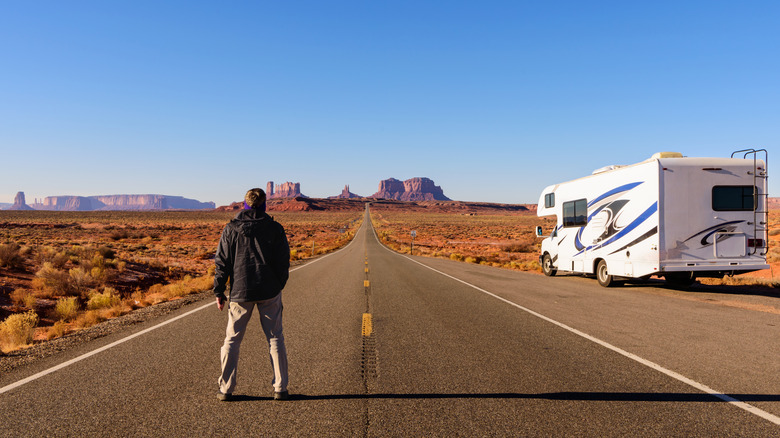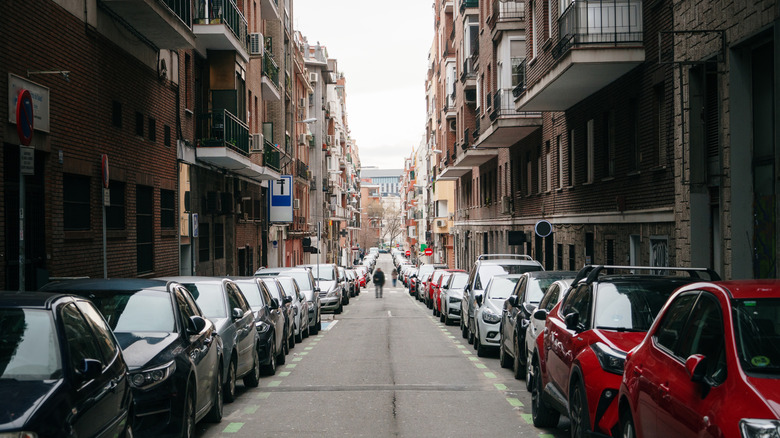A Major Difference Between America Vs Europe When Road Tripping In A Van Or RV
There are tons of similarities between certain countries in Europe and the United States, and an adoration for van-life is certainly one of them. The United States is sprawling and expansive, and people can move freely between states so road tripping with a van RV is a wonderful way to travel. Similarly, citizens of the European Union can freely move between countries to explore neighboring nations.
During the summer months, you're likely to see plenty of campers and RVs making their way towards the coasts and national parks in both the U.S. and Europe. Both are ideal places for unforgettable road trips. Although some Europeans may opt for more eco-friendly methods of transportation, like train travel, road tripping in a camper is still quite popular. That being said, certain aspects of traveling in a camper van or RV in Europe can take some American tourists by surprise.
Road tripping in a van or RV, which is commonly referred to as "caravaning" in Europe, may be slightly more challenging for American drivers. Throughout many parts of Europe, the roads are much narrower than they are in the United States, and navigating them safely may take some getting used to.
North America and Europe have very different road widths
On my first trip to Europe, my mom and I decided to rent a caravan and explore Ireland. I only had two weeks off work, and we wanted to see as much as possible. We picked up our David Bowie-themed camper van rental, hit the road, and quickly discovered that we were woefully unprepared for the narrow European streets. The average residential street in the United States is around 50 feet wide, whereas the European average is 15 to 25 feet wide. Just moments into our drive, we turned onto a tiny residential street and side-swiped a hedge, nearly knocking our rear-view mirror clean off.
City driving was the most challenging due to traffic and parked cars, but rural roads weren't much wider. One day, as we were cruising down a winding country road through the rolling green hills of the Irish countryside, we suddenly came upon a large group of cyclists that turned out to be athletes practicing for the Tour de France. There was no opportunity to pass them on the single lane road, and so for about three hours we inched along at a snail's pace in our David Bowie van.
The experience turned out to be one of our most cherished travel memories, but had we been on a tight schedule, it could have been a very frustrating situation. It's a good idea for American travelers to prepare for traffic and congestion caused by the narrow roadways when traveling in an RV in Europe. The narrow roads are also the reason that most camper vans and RVs in Europe are much smaller than options you'll find in America. Don't expect to find semi-truck-sized campers across the pond.
Tips for caravaning on narrow roads
In simple terms, the United States' extensive highway systems were specifically designed for automobiles because of economic and population growth, as well as a rise in the popularity of owning cars. Many American cities have streets that predate automobiles; however, by the time many U.S. interstate highways, which were largely built with cars in mind in the 1950s, European cities had been well-established for hundreds of years. European streets were designed for foot traffic, horses, and carriages because cars didn't exist when they were built. Today, many roads in Europe integrate public transportation options, and cities are often very walkable, so there hasn't been a widespread effort to widen the roads.
While it may be challenging to drive a large RV or camper van on the streets of Europe, with a little preparation and practice, most travelers shouldn't have any major issues. If you rent a motorhome or camper in Europe, it's a good idea to choose the smallest option possible. Make sure it is equipped with blind spot mirrors so that you can see the surroundings clearly on narrow roads.
The best way to ensure that you don't have any issues or accidents is to take your time. It can be really stressful driving on a narrow road, especially in traffic. Try not to get overwhelmed and, above all, do not rush. If you find yourself struggling, don't be afraid to turn on your hazard lights. If people are in a hurry, they can pass you. Safety is more important than speed. Besides, you're on vacation, so you should enjoy the journey. Passing places are commonly found on many narrow roads throughout Europe. They're designed to allow cars to safely pass each other on narrow and single-lane roads. Make sure you watch for them and be prepared to get over when you encounter oncoming traffic as well.


